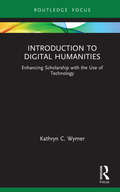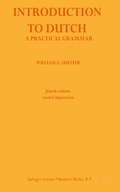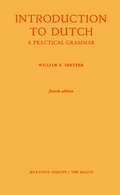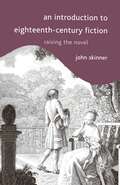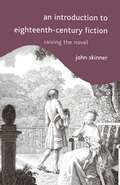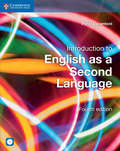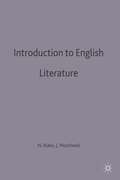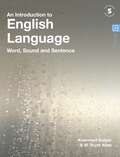- Table View
- List View
Introduction to Digital Humanities: Enhancing Scholarship with the Use of Technology (Routledge Focus on Literature)
by Kathryn C. WymerIntroduction to Digital Humanities is designed for researchers, teachers, and learners in humanities subject areas who wish to align their work with the field of digital humanities. Many institutions are encouraging digital approaches to the humanities, and this book offers guidance for students and scholars wishing to make that move by reflecting on why and when digital humanities tools might usefully be applied to engage in the kind of inquiry that is the basis for study in humanities disciplines. In other words, this book puts the "humanities" before the "digital" and offers the reader a conceptual framework for how digital projects can advance research and study in the humanities. Both established and early career humanities scholars who wish to embrace digital possibilities in their research and teaching will find insights on current approaches to the digital humanities, as well as helpful studies of successful projects.
Introduction to Digital Humanities: Enhancing Scholarship with the Use of Technology (Routledge Focus on Literature)
by Kathryn C. WymerIntroduction to Digital Humanities is designed for researchers, teachers, and learners in humanities subject areas who wish to align their work with the field of digital humanities. Many institutions are encouraging digital approaches to the humanities, and this book offers guidance for students and scholars wishing to make that move by reflecting on why and when digital humanities tools might usefully be applied to engage in the kind of inquiry that is the basis for study in humanities disciplines. In other words, this book puts the "humanities" before the "digital" and offers the reader a conceptual framework for how digital projects can advance research and study in the humanities. Both established and early career humanities scholars who wish to embrace digital possibilities in their research and teaching will find insights on current approaches to the digital humanities, as well as helpful studies of successful projects.
Introduction to Digital Video
by John WatkinsonCovers the essential fundamentals of digital video: from video principles, to conversion, compression, coding, interfaces and output. Written for television professionals needing to apply digital video systems, equipment and techniques to multimedia and /or digital TV applications, as well as for computer system designers, engineers, programmers, or technicians needing to learn how to apply digital video to computer systems and applications. The text is based on the acclaimed industry `bible' The Art of Digital Video, but covers only the essential parts of this larger reference work. It starts right from the basics from what a digital signal is to the how digital video can be applied. John Watkinson is an international consultant in Audio, Video and Data Recording. He is a fellow of the AES, a member of the British Computer Society and Chartered Information Systems Practitioner. He presents lectures, seminars, conference papers and training courses worldwide. He is author of many other Focal press books including MPEG2, Art of Digital Video, Art of Digital Audio, Art of Sound Reporduction, Introduction to Digital Audio, Television Fundamentals and Audio for Television. He is also co-author of the Digital Interface Handbook and a contributor to The Loudspeaker and Headphone Handbook.
Introduction to Digital Video
by John WatkinsonCovers the essential fundamentals of digital video: from video principles, to conversion, compression, coding, interfaces and output. Written for television professionals needing to apply digital video systems, equipment and techniques to multimedia and /or digital TV applications, as well as for computer system designers, engineers, programmers, or technicians needing to learn how to apply digital video to computer systems and applications. The text is based on the acclaimed industry `bible' The Art of Digital Video, but covers only the essential parts of this larger reference work. It starts right from the basics from what a digital signal is to the how digital video can be applied. John Watkinson is an international consultant in Audio, Video and Data Recording. He is a fellow of the AES, a member of the British Computer Society and Chartered Information Systems Practitioner. He presents lectures, seminars, conference papers and training courses worldwide. He is author of many other Focal press books including MPEG2, Art of Digital Video, Art of Digital Audio, Art of Sound Reporduction, Introduction to Digital Audio, Television Fundamentals and Audio for Television. He is also co-author of the Digital Interface Handbook and a contributor to The Loudspeaker and Headphone Handbook.
An Introduction to Discourse Analysis
by Malcolm Coulthard C. N. CondlinThe central concern of this book is the analysis of verbal interaction or discourse. This first six chapters report and evaluate major theoretical advances in the description of discourse. The final chapters demonstrate how the findings of discourse analysis can be used to investigate second-language teaching and first-language acquisition and to analyse literary texts.
An Introduction to Discourse Analysis
by Malcolm Coulthard C. N. CondlinThe central concern of this book is the analysis of verbal interaction or discourse. This first six chapters report and evaluate major theoretical advances in the description of discourse. The final chapters demonstrate how the findings of discourse analysis can be used to investigate second-language teaching and first-language acquisition and to analyse literary texts.
An Introduction to Discourse Analysis: Theory and Method
by James Paul GeeDiscourse analysis considers how language, both spoken and written, enacts social and cultural perspectives and identities. Assuming no prior knowledge of linguistics, An Introduction to Discourse Analysis examines the field and presents James Paul Gee’s unique integrated approach which incorporates both a theory of language-in-use and a method of research. An Introduction to Discourse Analysis can be used as a stand-alone textbook or ideally used in conjunction with the practical companion title How to do Discourse Analysis: A Toolkit. Together they provide the complete resource for students studying discourse analysis. Updated throughout, the fourth edition of this seminal textbook also includes two new chapters: ‘What is Discourse?’ to further understanding of the topic, as well as a new concluding section. A new companion website www.routledge.com/cw/gee features a frequently asked questions section, additional tasks to support understanding, a glossary and free access to journal articles by James Paul Gee. Clearly structured and written in a highly accessible style, An Introduction to Discourse Analysis includes perspectives from a variety of approaches and disciplines, including applied linguistics, education, psychology, anthropology and communication to help students and scholars from a range of backgrounds to formulate their own views on discourse and engage in their own discourse analysis. This is an essential textbook for all advanced undergraduate and postgraduate students of discourse analysis.
An Introduction to Discourse Analysis: Theory and Method
by James Paul GeeDiscourse analysis considers how language, both spoken and written, enacts social and cultural perspectives and identities. Assuming no prior knowledge of linguistics, An Introduction to Discourse Analysis examines the field and presents James Paul Gee’s unique integrated approach which incorporates both a theory of language-in-use and a method of research. An Introduction to Discourse Analysis can be used as a stand-alone textbook or ideally used in conjunction with the practical companion title How to do Discourse Analysis: A Toolkit. Together they provide the complete resource for students studying discourse analysis. Updated throughout, the fourth edition of this seminal textbook also includes two new chapters: ‘What is Discourse?’ to further understanding of the topic, as well as a new concluding section. A new companion website www.routledge.com/cw/gee features a frequently asked questions section, additional tasks to support understanding, a glossary and free access to journal articles by James Paul Gee. Clearly structured and written in a highly accessible style, An Introduction to Discourse Analysis includes perspectives from a variety of approaches and disciplines, including applied linguistics, education, psychology, anthropology and communication to help students and scholars from a range of backgrounds to formulate their own views on discourse and engage in their own discourse analysis. This is an essential textbook for all advanced undergraduate and postgraduate students of discourse analysis.
Introduction to Dutch: A Practical Grammar
by William Z. ShetterFirst edition This grammar arose from the need for a concise presentation of the essentials of the Dutch language which could be used both for independent home study and in groups or classes under formal instruction. With the former aim in mind, the explanations have been made as self-explanatory as possible, and a complete key to the exercises has been provided in an appendix. In the interest of simplicity and ease of reference and review, each grammatical topic is discussed as fully as practicable in one place, and an effort has been made to include only one major grammatical feature in any one chapter. But since a solid foundation can more effectively be achieved through study under trained supervision or with a native speaker of the language, the presentation has also been made adapt able to this type of study. The brief fill-in exercises in each lesson provide a model for any amount of drill, and the dialogues and readings included at irregular intervals as well as the review selec tions placed after every few chapters can provide the necessary added practice in supervised instruction. Help should in any case be sought with the pronunciation, the principal stumbling-block in the way of either independent or supervised study.
Introduction to Dutch: A Practical Grammar
by William Z. ShetterFirst edition This grammar arose from the need for a concise presentation of the essentials of the Dutch language which could be used both for independent home study and in groups or classes under formal instruction. With the former aim in mind, the explanations have been made as self-explanatory as possible, and a complete key to the exercises has been provided in an appendix. In the interest of simplicity and ease of reference and review, each grammatical topic is discussed as fully as practicable in one place, and an effort has been made to include only one major grammatical feature in any one chapter. But since a solid foundation can more effectively be achieved through study under trained supervision or with a native speaker of the language, the presentation has also been made adapt able to this type of study. The brief fill-in exercises in each lesson provide a model for any amount of drill, and the dialogues and readings included at irregular intervals as well as the review selec tions placed after every few chapters can provide the necessary added practice in supervised instruction. Help should in any case be sought with the pronunciation, the principal stumbling-block in the way of either independent or supervised study.
An Introduction to Eighteenth-Century Fiction: Raising the Novel
by John SkinnerThe formal and expressive range of canonic eighteenth-century fiction is enourmous: between them Defoe, Richardson, Fielding, Smollett and Sterne seem to have anticipated just about every question confronting the modern novelist; and Aphra Behn even raises a number of issues overlooked by her male successors. But one might also reverse the coin: much of what is present in these writers will today seem remote and bizarre. There is, in fact, only one novelist from the 'long' eighteenth century who is not an endangered species outside the protectorates of university English departments: Jane Austen. Plenty of people read her, moreover, without the need for secondary literature. These reservations were taken into account in the writing of this book.An Introduction to Eighteenth Century Fiction is a comprehensive and accessible introduction to English fiction from Aphra Behn to Jane Austen. It deals with novel criticism, canon formation and relations between genre and gender. The second part of the book contains an extensive discussion of Richardson and Fielding, followed by paired readings of major eighteenth-century novels, juxtaposing texts by Behn and Defoe, Sterne and Smollett, Lennox and Burney among others. The various sections of the book, and even the individual chapters, may be read independently or in any order. Works are discussed in a way intended to help students who have not read them, and even engage with some who never will. The author consumes eighteenth-century fiction avidly, but has tried to write a reader-friendly survey for those who may not.
An Introduction to Eighteenth-Century Fiction: Raising the Novel
by John SkinnerThe formal and expressive range of canonic eighteenth-century fiction is enourmous: between them Defoe, Richardson, Fielding, Smollett and Sterne seem to have anticipated just about every question confronting the modern novelist; and Aphra Behn even raises a number of issues overlooked by her male successors. But one might also reverse the coin: much of what is present in these writers will today seem remote and bizarre. There is, in fact, only one novelist from the 'long' eighteenth century who is not an endangered species outside the protectorates of university English departments: Jane Austen. Plenty of people read her, moreover, without the need for secondary literature. These reservations were taken into account in the writing of this book.An Introduction to Eighteenth Century Fiction is a comprehensive and accessible introduction to English fiction from Aphra Behn to Jane Austen. It deals with novel criticism, canon formation and relations between genre and gender. The second part of the book contains an extensive discussion of Richardson and Fielding, followed by paired readings of major eighteenth-century novels, juxtaposing texts by Behn and Defoe, Sterne and Smollett, Lennox and Burney among others. The various sections of the book, and even the individual chapters, may be read independently or in any order. Works are discussed in a way intended to help students who have not read them, and even engage with some who never will. The author consumes eighteenth-century fiction avidly, but has tried to write a reader-friendly survey for those who may not.
An Introduction to Element Theory
by Phillip BackleyDescribing a new and appealing way of analysing speech sounds, this book introduces you to the theory of elements in phonology. Traditional features are capable of describing segments and segmental patterns, but they are often unable to explain why those patterns are the way they are. By using elements to represent segmental structure, we begin to understand why languages show such a strong preference for certain kinds of segments, contrasts, phonological processes and sound changes. Using examples from a wide range of languages, this book demonstrates the process of analysing phonological data using elements, and gives readers the opportunity to compare element-based and feature-based accounts of the same phonological patterns. Backley also challenges traditional views through his innovative analysis of English weak vowels and diphthongs and hsi unified treatment of linking r and intrusive r as glide formation processes. Providing a thorough introduction to the main topics in segmental phonology, this is an excellent overview for both students with a background in standard phonology as well as for those who are new to the field. Key Features * Provides a full and up-to-date description of Element Theory * Includes examples from many languages and various dialects of English * Further reading suggested for each topic * Contains over 100 illustrations, including spectral and spectrographic figures
An Introduction to Element Theory
by Phillip BackleyA fresh alternative for describing segmental structure in phonology
Introduction To English As A Second Language Coursebook With Audio Cd (Cambridge International IGSCE)
by Peter LucantoniIntroduction to English as a Second Language is a course to prepare students for studying at IGCSE or equivalent level. Presented in a colourful updated design and offering clear, practical support for students, it follows a variety of interesting themes and topics, with a focus on skills development: listening, speaking, reading and writing. Each unit provides opportunities for thinking and discussion, along with developing research and study skills. Furthermore, each unit has a specific language-focus section to revise and consolidate key areas of language awareness and activities for vocabulary building. Audio CD is included for use with the listening activities.
An Introduction to English Grammar
by Gerald Nelson Sidney GreenbaumAn Introduction to English Grammar provides a comprehensive overview of all aspects of English grammar. The first part of the book (‘The Grammar’) provides a step-by-step introduction to the key topics in English grammar. The second part (‘The Applications’) shows how a grasp of these topics can be helpful in resolving usage problems, in developing a clear writing style, and in mastering punctuation and spelling. A whole chapter, ‘English in Use’, is devoted to illustrating the grammatical features of a wide range of modern text types, including emails, Facebook pages, and ‘tweets’. It also looks at the special grammatical features of English in everyday conversation. Each chapter is followed by two sets of exercises. The first set can be used in self-study or in the classroom. The second set deals with more advanced topics, and can be used for classroom discussion or essay writing. This fourth edition has been fully revised and updated and includes: clearer descriptions and improved presentation new material on word structure and word formation new exercises, examples and extracts updated further reading Assuming no prior knowledge of English grammar, this book is ideal for beginning students on a one-semester course and provides everything a student needs on the theory and practice of English usage. A comprehensive Glossary of grammatical terms is included and a website provides invaluable additional exercises.
An Introduction to English Grammar
by Gerald Nelson Sidney GreenbaumAn Introduction to English grammar provides a comprehensive overview of all aspects of English grammar, and can be used in the classroom, for self-study, or as a reference book. The book is organised in two parts – on grammar and its applications – and provides everything a beginning student needs to get to grips with the theory and practice of English usage, including sections on style, punctuation and spelling. This third edition has been fully revised and updated to include an expanded section on English in Use, usage notes highlighting common errors, updated exercises, a glossary and a companion website with further graded exercises.
An Introduction to English Grammar
by Gerald Nelson Sidney GreenbaumAn Introduction to English grammar provides a comprehensive overview of all aspects of English grammar, and can be used in the classroom, for self-study, or as a reference book. The book is organised in two parts – on grammar and its applications – and provides everything a beginning student needs to get to grips with the theory and practice of English usage, including sections on style, punctuation and spelling. This third edition has been fully revised and updated to include an expanded section on English in Use, usage notes highlighting common errors, updated exercises, a glossary and a companion website with further graded exercises.
An Introduction to English Grammar
by Gerald Nelson Sidney GreenbaumAn Introduction to English Grammar provides a comprehensive overview of all aspects of English grammar. The first part of the book (‘The Grammar’) provides a step-by-step introduction to the key topics in English grammar. The second part (‘The Applications’) shows how a grasp of these topics can be helpful in resolving usage problems, in developing a clear writing style, and in mastering punctuation and spelling. A whole chapter, ‘English in Use’, is devoted to illustrating the grammatical features of a wide range of modern text types, including emails, Facebook pages, and ‘tweets’. It also looks at the special grammatical features of English in everyday conversation. Each chapter is followed by two sets of exercises. The first set can be used in self-study or in the classroom. The second set deals with more advanced topics, and can be used for classroom discussion or essay writing. This fourth edition has been fully revised and updated and includes: clearer descriptions and improved presentation new material on word structure and word formation new exercises, examples and extracts updated further reading Assuming no prior knowledge of English grammar, this book is ideal for beginning students on a one-semester course and provides everything a student needs on the theory and practice of English usage. A comprehensive Glossary of grammatical terms is included and a website provides invaluable additional exercises.
Introduction to English Language
by N.F. Blake Jean MoorheadA comprehensive, introductory coursebook for English Language 'A' and 'A/S' level students on any of the examination courses and suitable for Introduction to English Language courses at undergraduate level. The sections cover all the common topics of study, including grammar, language analysis, language acquisition, language varieties and change, language and society and language and style. A final section gives useful help on preparing a language project.
An Introduction to English Language: Word, Sound And Sentence
by Koenraad Kuiper W. Scott AllanHave you ever noticed something unusual about vocabulary or pronunciation and wanted to know more? Have you ever wondered how the building blocks of language fit together? Do you want to understand the different ways speakers of English communicate with each other? Back for its fourth edition, An Introduction to English Language is essential reading for students of English language and linguistics. Combining accessibility with depth, it is a textbook that assumes no prior knowledge and will serve as an ideal companion for anybody approaching this subject for the first time. This revised and updated fourth edition of An Introduction to English Language:• Is packed with fresh material, including a brand new chapter on pragmatics• Includes a range of in-text activities and exercises for practicing what you've learned as you go• Is accompanied by an interactive ebook which allows you to access media resources while you're on the move. The book's learning materials (including Powerpoint slides, downloadable sound files and video tutorials) are also freely available on the book's companion website: https://he.palgrave.com/companion/Kuiper-and-Allan-An-Introduction-To-English-Language/
An Introduction to English Language
by Koenraad Kuiper W. Scott AllanBack for its fourth edition, this core textbook offers a clear and engaging introduction to the building blocks of the English language, namely its words, sounds and sentences. Assuming no prior knowledge, this text combines accessibility with depth and is an ideal companion for anyone with an interest in how language works. Written by experienced and respected lecturers in the field, this book strips the subject down to its bare bones and offers detailed and clear explanations of key topics and theories, including variation in vocabularies, the International Phonetic Alphabet and relevance theory in relation to pragmatics.This is essential reading for undergraduate students of English language and linguistics. It is also a valuable resource for students on ESOL courses and teachers of English as a second or foreign language. It can be used as a stand-alone introductory text, or as a precursor to more advanced material. New to this Edition:- Brand new section on pragmatics, complete with downloadable e-resources available on the companion website- Fully revised and updated throughout, with a fresh text design and new examples- References to cognition and language introduced throughout the book in an accessible way
An Introduction to English Language: Word, Sound and Sentence
by Koenraad Kuiper W. Scott AllanRefreshed and updated, the fifth edition of this core textbook offers a clear and engaging introduction to the building blocks of the English language, namely its words, sounds and sentences. Assuming no prior knowledge, it combines accessibility with depth, offering detailed explanations of key topics and theories, including variation in vocabularies, the International Phonetic Alphabet and relevance theory in relation to pragmatics. Packed full of exercises to help consolidate learning, and equipped with examples and illustrations throughout, An Introduction to English Language is essential reading for undergraduate students of English language and linguistics and a valuable resource for students and teachers of English as a second or foreign language. This new edition features: - An enhanced text design - Updated examples - Refreshed illustrations - New and improved exercises - Revised further reading lists. The book is divided into three parts, with succinct overviews and clearly-defined learning outcomes at the start of each section, followed by glossaries of technical terms at the end. It is also accompanied by a wealth of online resources, including downloadable PowerPoints, MP3 audio files, MP4 video lectures, and quizzes, further supporting readers in achieving their goals.
An Introduction to English Language: Word, Sound and Sentence
by Koenraad Kuiper W. Scott AllanRefreshed and updated, the fifth edition of this core textbook offers a clear and engaging introduction to the building blocks of the English language, namely its words, sounds and sentences. Assuming no prior knowledge, it combines accessibility with depth, offering detailed explanations of key topics and theories, including variation in vocabularies, the International Phonetic Alphabet and relevance theory in relation to pragmatics. Packed full of exercises to help consolidate learning, and equipped with examples and illustrations throughout, An Introduction to English Language is essential reading for undergraduate students of English language and linguistics and a valuable resource for students and teachers of English as a second or foreign language. This new edition features: - An enhanced text design - Updated examples - Refreshed illustrations - New and improved exercises - Revised further reading lists. The book is divided into three parts, with succinct overviews and clearly-defined learning outcomes at the start of each section, followed by glossaries of technical terms at the end. It is also accompanied by a wealth of online resources, including downloadable PowerPoints, MP3 audio files, MP4 video lectures, and quizzes, further supporting readers in achieving their goals.
An Introduction to English Lexicology: Words, Meaning and Vocabulary
by Howard Jackson Etienne Zé AmvelaWhat are words? Where do words come from? How are they used?Answering these questions and more, this book guides you through the key concepts in the lexicology of modern English. Providing an overview which encompasses all aspects of English vocabulary, this book explains the sources of modern English words and shows how the vocabulary has developed over time. Thoroughly updated throughout to keep pace with recent developments in the field, this third edition features:- Enhanced chapters on vocabulary, dictionaries and investigative lexicology- New sections on contemporary topics such as internet language, social media and youth culture- Guides to new electronic resources and tools of analysis- Exercises throughout each chapter, with an updated answer key- A revised list of suggestions for further readingAssuming no prior knowledge of linguistics, and featuring exercises and a fully updated glossary of lexicological terms to support your learning, An Introduction to English Lexicology is the only book you need to understand the basics of English lexicology.
